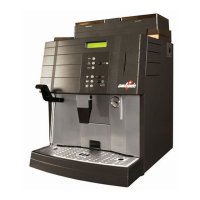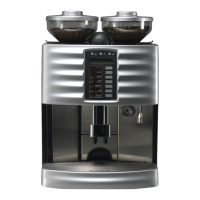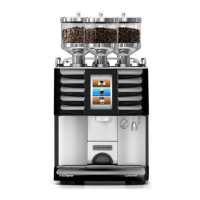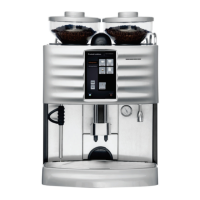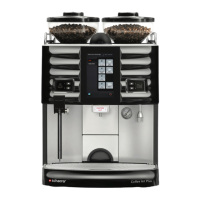Chapter 3 Functional descriptions
SMSO-2-02.03- 15.07.03 31
3.1.8 Calcium (limescale)
Besides very low quantities of minerals tap water often con-
tains a high proportion of bi-carbonate. Depending on the
proportion involved the water is designated “soft” or “hard”.
When the water heats up these bi-carbonates turn into cal-
cium deposits, i.e. limescale, particularly inside the instant
heaters and the steam elements, and also inside the pipes
and valves. The calcium deposits lead to a poor quality of
energy transfer, and thus to an increase in power consump-
tion, hard seals and gaskets, and shorter service life of com-
ponents. And besides the encrusted deposits, there are often
calcium particles floating freely in the water. These free parti-
cles of calcium can cause a wide variety of faults (reduction in
pipe cross-sections, clogging of valve seats, baffles and fil-
ters).
In order to make a high quality coffee, the water must contain
a certain amount of calcium. If the proportion of calcium is too
low the coffee’s aroma cannot develop fully, the brewing time
becomes longer, and the milk in the coffee coagulates, the
cream becomes flat and unstable. (see “water specifications”).
However, the problem of calcium is not solved by removing all
the calcium from the water with a water softening system. It is
equally unfavourable, if the water is processed through a wa-
ter softener, to have a pH value that is too high (acid) or too
low (alkaline). These properties cause increased corrosion in
pipes and thus an increased risk of leaks.
For this reason service technicians must always be aware of
the latent hazards and problems caused by calcification and
calcium damage.
When maintenance work is carried out, components with de-
posits of calcium can be treated in two ways:
1. The part is replaced. Some components must be replaced
when they are covered with calcium deposits, with others
it is not worth the time involved in decalcifying, or they
may not work efficiently after the decalcifying operation.
The instant heater and the steam generator must never
be decalcified.
2. The component is decalcified: There are relatively few
components that may be decalcified. The table below
shows, which parts these are; the information in the table
is final.
Description of the part
Part
number
Clean Replace
Steam feed pipe 063'404 x x *
HW valve pipe 063'205 x x *
Pipe 063'405 x x *
Coffee hot water feed
pipe
063'304 x x *
Tea hot water feed pipe 063'204 x x *
Level probe 067'068 x
Flow meter 061'226 x x *
Safety valve pipe 065'154 x x *
*Replace if the part is too heavily calcified
The decalcification process can be carried out using standard
decalcifying agents available on the market. Always follow the
instructions on the decalcifying agent pack. Thoroughly rinse
the treated components after the decalcification process.
If you establish, that there are unusually heavy deposits of
calcium on the components, you should carry out a water
hardness test, and depending on the result, discuss with the
customer what measures should be taken to reduce calcium
damage in the future.
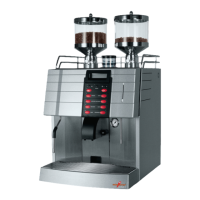
